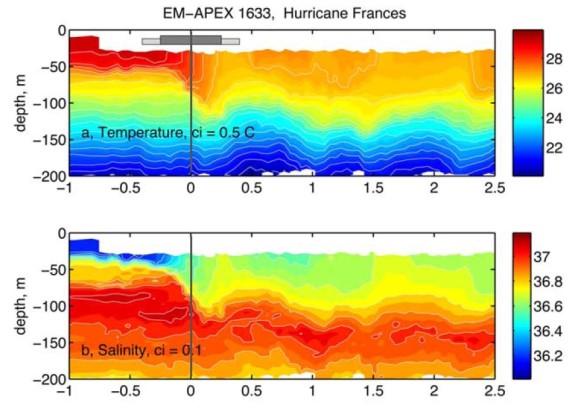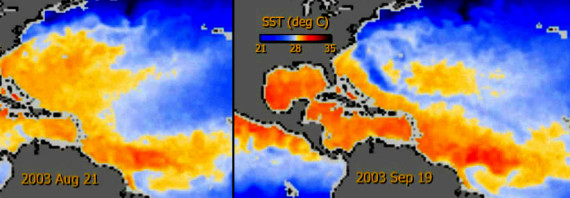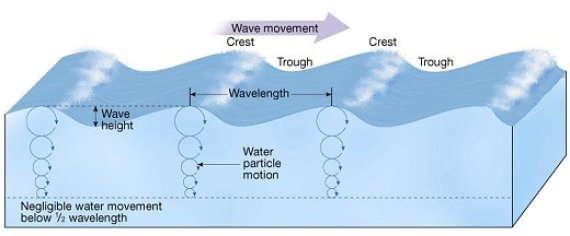We think we’re pretty familiar with hurricanes – strong winds, storm surge, flooding rains, ominous satellite images from space, and radar loops when they get near land. But what goes on at and below the ocean’s surface when a hurricane passes overhead? Quite a lot, actually!
Effects on the ocean properties
The upper levels of the ocean are typically strongly stratified by temperature and by salinity. That is, colder, saltier water lies below the warmer, fresher water near the surface. When a hurricane comes by, it mixes everything up, resulting in a muddled and more homogeneous upper ocean. That means the surface water is cooler and saltier than it was previously was, and deeper water is warmer and less salty than it previously was. However, in very shallow coastal areas, the copious amount of fresh cold rain water from the hurricane can actually reduce the temperature and salinity of the near-surface water.

Time series of the vertical profile of temperature and salinity from the ocean’s surface down to 200m, and spanning one day prior to the hurricane’s passage through 2.5 days after the passage. The dramatic mixing down to approximately 150m is evident. Time in days relative to the passage is listed along the horizontal axis. This particular case is from Hurricane Frances (2004) on 1 September. (Sanford et al., 2007)
The colder surface water upwelled by the hurricane can actually be a fairly significant player in controlling the hurricane’s intensity. A strong slow-moving hurricane will upwell cold water much more effectively than a weaker and/or fast-moving hurricane. And since hurricanes require warm ocean water to fuel their “engine”, that upwelling can end up weakening the storm. The trail of upwelled cooler water left behind a storm is called a “cold wake”, and shows up clearly on maps of sea surface temperature.

Map of sea surface temperature before (left) and after (right) Hurricane Isabel in 2003. Isabel’s track from the eastern Atlantic all the way into the mid-Atlantic coast is evident by the cold wake left behind. (NASA/GSFC)
Intense hurricanes can generate 60′+ waves, and at the ocean surface, the boundary between the water and the air becomes nebulous. Amidst the formidable waves, sea spray and foam streak horizontally across the surface at high speed, blurring the view of the ocean’s surface in this photo from an aircraft flying through a hurricane.

Photo of the sea state under Category 4 Hurricane Isabel taken from 400 feet above the surface. Note that the aircraft was not in or near the eyewall at this time or altitude. (Will Drennan, RSMAS)
But below the ocean’s surface, the currents and turbulence beneath those waves can also be quite destructive. Unlike places above the surface, the ocean doesn’t “forget” about the storm very quickly… strong currents and turbulence have been known to exist up to a week after the storm passes overhead. Damaging currents can extend down to at least 300 feet below the surface, capable of dismantling coral reefs, relocating ship wrecks, breaking oil pipelines, and displacing huge volumes of sand on the seabed.

Simplified schematic showing the parts of an ocean wave. At the surface, there are crests and troughs. Crests are separated by a wavelength. The depth to which a wave’s effects can be felt depends on the wavelength and wave height.
Effects on marine life
Some studies conducted in the Caribbean Sea have shown that in the year following a hurricane, coral cover is reduced by 15-20 percent (more or less, depending on the intensity of the hurricane) in the affected areas. There are several factors that go into the negative effect on coral: 1) the turbulent water breaks it, 2) the days of muddied water reduces the amount of sunlight reaching the algae in coral tissue, 3) the fine suspended particles clog the pores, and 4) the tremendous amount of rain reduces the salinity of the shallow ocean in the immediate area which can stress coral.
Large self-propelled marine animals such as sharks seem to be minimally affected, since they can detect tiny changes in pressure as larger waves at the surface approach, as well as the reduced surface pressure associated with the storm itself, and go deeper or leave the area. However, hurricanes have been known to result in tremendous numbers of dead fish, crabs, sea turtles, oysters, etc due to reduced amounts of dissolved oxygen in the water, rapid salinity changes, and violent surf.
Just like us up here on the surface, marine life suffers for months to several years from the death and destruction following a hurricane.
Brian McNoldy
Senior Research Associate
University of Miami Rosenstiel School of Marine and Atmospheric Science
Author of Tropical Atlantic Update
Follow Brian on Twitter: @BMcNoldy
(Flickr photo via Surf Cabo)
